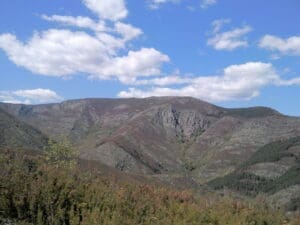The designation of origin of this artisanal bread, recognized in 2004, includes 18 ovens in the municipality of San Cristovo de Cea, on the Mozarabic Way – Silver Route to Santiago de Compostela. It is a wheat bread recognizable by its elongated shape, rounded at the ends, and with a large transverse groove on the top. Its crust is thick and crunchy, and the crumb is spongy and uneven. The origins of this baking tradition are linked to the nearby Oseira monastery and also to the passage of pilgrims to Santiago, who found hospitality here during the Middle Ages. “Pan de Cea” is defined as bread made with wheat flour, of which 50% comes from varieties of the Autonomous Community of Galicia known as “del país”, with the addition of potable water and edible salt, to which sourdough from a previous batch is added for fermentation. The kneading is done in several stages, following the ancestral techniques of the area, through a laborious artisanal process. Finally, the dough is baked in circular granite stone ovens with a characteristic design of the area.
The main characteristics of Pan de Cea are as follows:
* Shape of the Pan piece: Elongated and rounded at the ends, with a transverse groove in the center of the top, called “fenda”, dividing the piece into two equal curved and interlocked parts. * Presentations: Two types of presentations that differ by weight and dimensions: Piece or “Poia”: Weight between 1 and 1.2 Kg. Half Piece or “Molete”: Weight between 0.5 and 0.6 Kg. * Crust or “codia”: Thick with variable width, even in the same piece, hard and rigid consistency, and tends to form layers. Its color ranges from golden to dark chestnut. Toasted flavor. * Crumb or “miolo”: Spongy, fibrous, and firm texture. Not very abundant alveolation, distributed irregularly and of very variable size. Parchment color, reminiscent of whole wheat grain. Intense wheat flavor.
The production of the product follows an artisanal process passed down from generation to generation, adapting to current legislation without losing its unique and characteristic identity. The process consists of the following phases; – KNEADING: The flour is placed in a shape similar to a volcano, adding water with salt and sourdough from the previous batch, called “formento”, in the center. Then, kneading is done manually for 60 minutes. – REST (Sleeping the child-Durmilo neno): The dough is left to rest for 45 to 60 minutes. It must have the right temperature, so it is covered with a cotton cloth and a blanket if necessary. – DIVIDING THE DOUGH (Tasar): The dough is manually divided after resting into portions weighing approximately 1.5 Kg or 0.75 Kg, depending on the format to be made. – RE-KNEADING (Tendas): Each re-kneading operation is called a tenda, with a subsequent rest of 25 to 30 minutes. The production process usually undergoes three tendas, which can be reduced to two if conditions are favorable. – INTRODUCTION INTO THE OVEN (enfornado): To introduce the dough into the oven, it is placed on the paddle (pa) and a cut is made in the center of the top. The process of introducing the dough into the oven is done in several stages, while redistributing the pieces in the oven (anda-lo pan), moving them away from the heat source. The oven is preheated using wood or other vegetable materials that do not provide odor or flavor. – BAKING: Once the entire batch is placed, the oven is closed, leaving a baking time of approximately 120 minutes. – REVER: Once out of the oven, the pieces must mature, cooling for an hour on wooden slats.
Corporate Image
The chosen logo for Pan de Cea had to be simple and almost artisanal, creating a brand image both in its graphics and typography, and that from the first moment it would be identified with the product.
Therefore, a flat, one-dimensional image was chosen, free of complications and representing much more than it appears, as it not only resembles our bread but also represents the beginning of the entire process, symbolizing the farmlands with the different colors they take depending on when they are worked or the quality of the soil itself. Overall, a logo was conceived that aims to combine the idea of timelessness, surviving from ancient to modern times, while establishing a visual metaphor with the real reference: Pan de Cea.
Pan de Cea Exaltation Festival
Every first Sunday of July since 1991, the Pan de Cea Exaltation Festival is held in the Campo de la Saleta de Cea. The surroundings of the Chapel of the highly revered Virgin of La Saleta become a must-visit meeting point to taste the famous product made by the Bakers of Cea. Year after year, the festival gains in presence and today it is marked on many people’s calendars as an unmissable event…

 Galicia
Galicia










 Provincia de Ourense
Provincia de Ourense 










